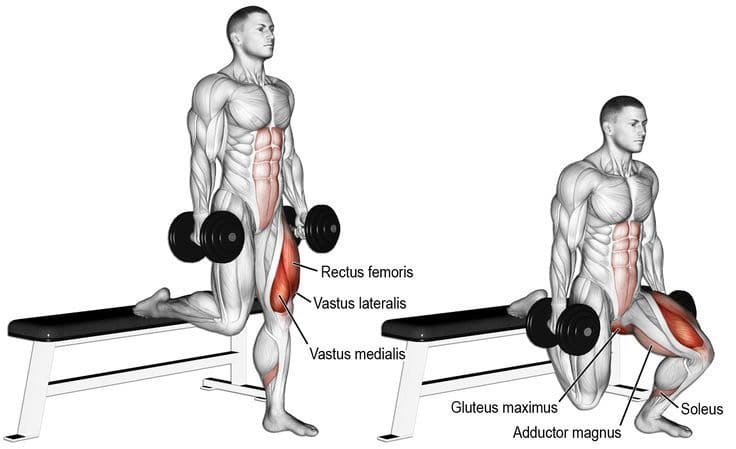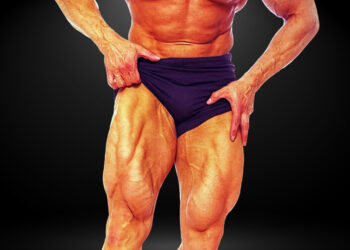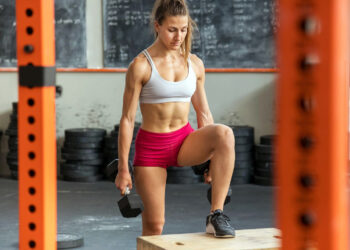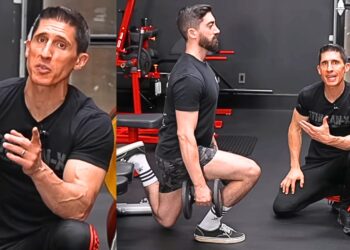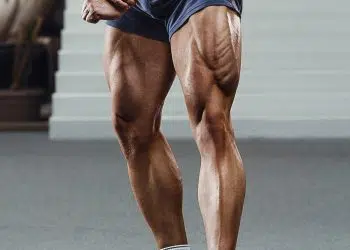I remember the first time I did Bulgarian split squats. I’d been on a steady diet of back squats, leg presses, and deadlifts for several years and had built a decent amount of strength. However, I was starting to see a slight difference in size from my left leg to my right and figured it was time to start doing some unilateral leg training to even things out.
Thinking I was too advanced for lunges and step-ups, I dived straight into Bulgarian split squats. Needless to say, it was a shock to the system. I quickly ditched the dumbbells I’d planned to use and just did the exercise with my bodyweight.
Despite the low load, my legs shook like Bambi on ice! It was soon evident that I needed to work on my stabilizer strength, as well as my balance and mobility. The following days’ post-exercise muscle soreness was beyond measure; there wasn’t a single part of my legs that wasn’t painful to the touch!
As you’d expect from an ardent exerciser, none of this put me off Bulgarian split squats. Instead, I became a convert and made them a staple of my training.
Unfortunately, like any exercise, the effects of Bulgarian split squats gradually started to diminish until, after several months, all progress ground to a halt. Your body adapts quickly to new stresses and, once the shock has worn off, even the best exercise will lose some of its potency. That’s why smart lifters change their workouts every 6-8 weeks.
So, to help you avoid the same training rut, in this article, we’re going to share the 12 best Bulgarian split squat alternatives. Use them to keep your workouts productive.
Level Up Your Fitness: Join our 💪 strong community in Fitness Volt Newsletter. Get daily inspiration, expert-backed workouts, nutrition tips, the latest in strength sports, and the support you need to reach your goals. Subscribe for free!
Bulgarian Split Squat Anatomy
To be a viable alternative to Bulgarian split squats, any exercise must involve most of the same muscles. For clarity, these are the main muscles involved in Bulgarian split squats:
Quadriceps – known as the quads for short, these are the muscles on the front of your thigh and are responsible for knee extension. The four quadriceps are rectus femoris, vastus lateralis, vastus intermedius, and vastus medialis.
Hamstrings – located on the back of your thigh, the hamstrings are responsible for hip extension and knee flexion. There are three hamstring muscles; biceps femoris, semimembranosus, and semitendinosus.
Gluteus maximus – glutes for short, and also known as your butt, this is the largest muscle in the human body. It works with your hamstrings to extend your hip. It also plays a minor role in hip abduction and rotation.
Hip adductors – made up of adductor longus, brevis, and magnus, this group of muscles works together to draw your thigh in toward the midline of your body. In Bulgarian split squats, their main job is to keep your hips stable and stop your knees from falling outward.
Hip abductors – these muscles are located on the outside of your hip and thigh. They are responsible for taking your thigh out and away from the midline of your body. Gluteus minimus, gluteus medius, and tensor fasciae latae (TFL) are all hip abductor muscles.
Like the adductors, the hip abductors main job is keeping your hip stable, preventing your knees from dropping in. Stronger, more stable hips can help reduce the risk of developing knee pain (1).
Core – core is the collective term for the muscles of your midsection. If you do Bulgarian split squats with weights, you’ll need to use your core to stabilize your spine. These muscles act like a natural weightlifting belt to increase intra-abdominal pressure, which helps support your spine and take stress off your intervertebral discs.
Top 12 Bulgarian Split Squat Alternatives
Maintain your progress and avoid training ruts with these equally effective Bulgarian split squat alternatives!
1. Smith machine Bulgarian split squat
A lot of people are very quick to dismiss the Smith machine. They point out that, because the weights are guided by rods, any exercise done on the Smith machine is not functional. However, for the purpose of hypertrophy, that perceived drawback is actually a benefit. It leaves you free to pushing your muscles to the limit.
If you find balancing during Bulgarian split squats tricky or just want to take your sets to failure in relative safety, this could be the exercise for you.
How to do it:
- Place a bench a couple of feet behind a Smith machine. Rest and hold the bar across your shoulders. Bend one leg and place your foot on the bench behind you. Brace your core.
- Bend your legs and lower your rearmost knee down toward the floor.
- Stand back up and repeat.
- Rest a moment, swap sides, and do the same number of reps on the other leg.
2. Bulgarian split squat jumps
This explosive split squat variation will increase lower body muscle power, one leg at a time. Power if your ability to generate force quickly and is an integral part of most sports. However, this is a high-impact exercise and best avoided if you have ankle, knee, hip, or lower back issues.
How to do it:
- Stand with your back to an exercise bench. Bend one leg and place your foot on the top. Hop forward and into a split stance. Brace your abs.
- Bend your legs and lower your rearmost knee down toward the floor.
- Explosively extend your front leg and drive up and off the floor.
- Land on a slightly bent knee, descend and repeat.
- You can also do this exercise with dumbbells in your hands for added resistance.
3. TRX Bulgarian split squats
No bench? No problem! You can also do Bulgarian split squats using a TRX. TRX Bulgarian split squats require and develop good balance and mobility, making them more challenging than the standard version.
How to do it:
- Standing with your back to your TRX, place one foot in the handle. Brace your core.
- With most of your weight on your front leg, bend your knees and push your rear leg backward, taking care not to hyperextend your hip.
- Descend until your front thigh is roughly parallel to the floor.
- Stand back up and repeat.
- Rest a moment, swap sides, and do the same number of reps on the other leg.
4. Deficit reverse lunges
Lunges are often viewed as a prerequisite for Bulgarian split squats. And while they do require less balance, that doesn’t mean they’re an easy option. Because you’re more stable, you’ll be able to use more weight, and that’s good for building strength and muscle mass.
Deficit reverse lunges involve a larger range of motion than regular lunges, making them even more challenging.
How to do it:
Level Up Your Fitness: Join our 💪 strong community in Fitness Volt Newsletter. Get daily inspiration, expert-backed workouts, nutrition tips, the latest in strength sports, and the support you need to reach your goals. Subscribe for free!
- Stand on a 4 to 6-inch platform, such as a couple of stacked bumper plates. Brace your core.
- Take a large step back, bend your legs, and lower your rearmost knee down to within an inch of the floor, taking care not to hyperextend your hip.
- Push off your back leg and return to your platform.
- Repeat on the same leg, or alternate sides are preferred.
- Make this exercise harder by using dumbbells. You can also do reverse deficit lunges with a Smith machine.
5. Step-through lunges
This move combines forward and backward lunges into one exercise. It’s a demanding exercise that requires good balance and coordination. The constant weight shifts really fire up your hip abductors, adductors and glutes, making this an excellent move for improving hip and knee stability.
Because it keeps your muscles under tension for longer, you won’t need a lot of weight to feel this exercise working.
How to do it:
- Stand tall with your feet together and your hands by your sides. Look straight ahead and not down at the floor. Brace your abs.
- Take a large step forward, bend your legs, and lower your rear knee down to within an inch of the floor.
- Push off your front leg and step straight back into a reverse lunge. Do not “touch down” as you move between forward to backward lunges.
- Push off your back leg and go straight into another forward lunge.
6. Split squats
You need good balance and hip mobility to do Bulgarian split squats. If you find them a little too challenging, you can get many of the benefits by doing the same exercise with both feet planted firmly on the floor. This is also a handy option for those times when you may not have access to a suitable bench.
How to do it:
- Stand with your feet together and your arms by your sides. Look straight ahead and stand up tall in good posture.
- Take a large step forward and then stop.
- With your abs braced and your torso upright, bend your legs and lower your rearmost knee down to within an inch of the floor. Your front shin should be close to vertical and your leading knee behind your toes. About 70% of your weight should be on your front leg.
- Without moving your feet, stand back up, pause, and then descend again.
- Rest a moment and then repeat on the opposite leg.
Read more about split squats here.
7. Split squat jumps
This exercise will increase lower body power. It’s a high-impact move that’s best left to more advanced exercisers. But, if you play sports, this could be a good move for increasing your jumping and running abilities.
How to do it:
- Step out and into a split stance. Bend your legs and lower your rear knee down toward the floor.
- Using your arms for extra momentum, jump up and into the air.
- Land with your knees slightly bent and then descend into another rep.
- Continue for the prescribed number of reps.
- Rest a moment and then repeat on the opposite side.
- You can also do this exercise using an alternating leg action, swapping legs in midair before landing.
8. Single-leg Romanian deadlift
While single-leg Romanian deadlifts don’t look much like Bulgarian split squats, they involve many of the same muscles and share similar benefits. They’re not as quad-centric as split squats but probably provide your hamstrings and glutes with a better workout.
Find out how to do single-leg Romanian deadlifts here.
9. Non-alternating walking lunge with pause
Walking lunges are a popular exercise. However, done using an alternating leg action, they can be hard on your knees. You also give your legs a partial rest as you alternate sides. This unusual lunging variation fixes both these problems, delivering a knee-friendly workout that really challenges your quads by increasing time under tension.
How to do it:
- Stand with your feet together and your arms by your sides. Brace your core and look straight ahead.
- Take a large step forward and descend into a lunge. Pause for 1-2 seconds.
- Bring your rear leg in so your feet are together.
- Step forward with the same lead leg and repeat for the required number of reps.
- Rest a moment, and then do your next set leading with the opposite leg.
- Make this exercise harder by using dumbbells.
10. Curtsey lunge
The curtsey lunge is a backward lunge with a difference. Crossing your rear leg behind you increases abductor and adductor engagement, making this variation better for hip stability than regular lunges. Curtsey lunges are also good for hip mobility.
How to do it:
- Stand with your feet together and your arms down at your sides.
- Putting your weight on your right foot, step back and around with your left foot — just like you are curtsying. Descend until your right thigh is parallel to the ground.
- Straighten your right leg, pushing up through your heel, and return your left foot to the starting position.
- Repeat for the desired number of reps, and then switch legs.
11. Single leg press
A lot of people do Bulgarian split squats because they train one leg at a time. However, you need good balance to be able to do them correctly. Single leg presses allow you to focus on one leg at a time but without worrying about balance. As a result, you can push your muscles to failure in relative safety.
How to do:
- Sit on the leg press machine and slide your butt down and into the bottom of the seat. Place your foot on the footplate so it’s directly above or slightly outside your hip. Place your other leg safely out of the way.
- Extend your leg and press the weight up. Flip the safety catches out to the side, so the weight is free to move. Grip the support handles and brace your abs.
- Bend your knee and descend as far as your flexibility and knee health allows. Do not let your lower back round. Instead, keep it pressed into the backrest.
- Without bouncing, drive the weight back up, stopping just short of full knee extension.
- Do the same number of reps on each leg.
12. Single-leg stability ball wall squat
Single-leg Bulgarian split squats are usually described as a single-leg exercise. However, the reality is that it’s all but impossible not to use your rear leg for assistance.
With single-leg stability ball wall squats, you really will be using just one leg. Also, leaning against a stability ball and against a wall means this exercise is much easier to learn than pistol squats.
How to do it:
- Place a stability ball between your lower back and a wall. Stand with your feet together. Brace your core. Bend both legs and descend until your thighs are parallel to the floor. Lift one leg and extend your foot in front of you.
- Drive your opposite leg into the floor and stand up.
- Descend again and repeat.
More Squat Alternative Exercises:
- Front Squat Alternatives for Mass, Strength
- Hack Squat Alternative for Bigger, Stronger Legs
- Smith Machine Squat Alternatives for Powerful, Muscular Legs
- Home Squat Alternatives for Strong, Sculpted Legs
Bulgarian Split Squat Alternatives – Wrapping Up
Bulgarian split squats are a popular exercise. That’s because they’re effective and you don’t need a lot of equipment to do them. For a lot of people, bodyweight split squats are challenging enough, and even more advanced lifters don’t usually need to use a lot of weight to make them harder.
But, if you do Bulgarian split squats too often or for too long, you could become bored of them. They may even start to lose some of their benefits. Stick with them regardless, and your training progress will probably grind to a halt.
Keep your lower body workouts fun and productive with these Bulgarian split squat alternatives. Each one uses the same muscles and provides many of the same benefits.
Rotate leg exercises every 4-8 weeks to avoid training ruts and keep those gains coming!
References:
1 – PubMed: The Relationship Between Hip Muscle Strength and Dynamic Knee Valgus in Asymptomatic Females: A Systematic Review https://pubmed.ncbi.nlm.nih.gov/29859898/
Interested in measuring your progress? Check out our strength standards for Hip Abduction, Smith Machine Squat, Bulgarian Split Squat, and more.

